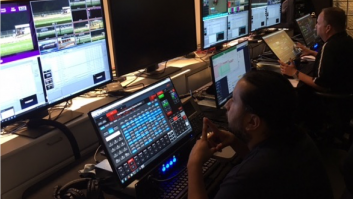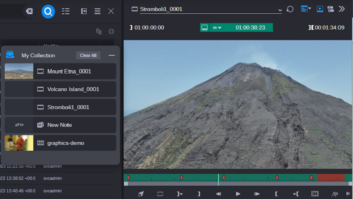In fast-paced live production environments, such as esports, the control layer can simplify a broadcast, whilst sharing and managing resources between system locations to save time, space and money. Each company has its own operations, processes, and workflows and by empowering operators and engineers to have complete control of the system, their job becomes much easier. Advanced control surfaces can ensure creative production freedom and the highest technical quality for esports applications.
Esports productions are very similar to traditional sports broadcasts, but the potential for exponentially more inputs and sources to choose from in the production control room creates an even greater need for advanced control. There is also an added workflow challenge when working with game servers and video game consoles acting as inputs. Advanced control and tally systems can help bridge the gap for production personnel in order to achieve a smooth broadcast or live stream. In addition, intuitive control interfaces enable users to establish seamless communication on a single, unified layer. With the ability to perform powerful actions without the need to invest in a system controller, universal control systems and panels can quickly and cost-effectively plug-in to any infrastructure or workflow, providing operators with the control they need over the devices they use. A well-designed control solution offers an intuitive user interface, providing increased flexibility for esports production personnel.
With increasing demands on resources, budgets, and the rapid adoption of IP and remote production, it is more important than ever for control systems to be able to hide underlying system complexities so that operators can remain focused on making great content. For esports applications in particular, it is important for the observer, the person tasked with managing the in-game cameras as well as identifying key moments in the game for replays and highlight reels, to have an advanced tally and control system because its helps to tie in the entire production ecosystem. Through a unified control layer, operators can share technology between multiple locations, simplifying the production process. This also reduces the risk for human error by putting the appropriate amount of control under the hands of a single operator and creates a seamless workflow that minimises training time. Additionally, with advanced broadcast control, users can decrease the number of operational control panels needed by managing the functionality across a controlled system via unified interfaces.
Routing control is another important component for esports applications Users need to be able to manage signal routes throughout a facility. This might include routing video, audio and data signals between the various elements of a network. Users need a system that will send a signal precisely where it’s needed while providing the flexibility and control to build an appropriate signal path for esports operations. Instead of the traditional requirement to route one video signal to one destination, ever-increasing video quality and resolution mean one destination is no longer enough. More bandwidth is required to group 3G data inputs to make a 4K source. This can be achieved by routing between blocks of quad inputs and outputs, by condensing four ‘levels’ in an association router into one destination. Additionally, with table routing capabilities, a cross point made within a connected matrix can be used to trigger another cross point. When a source is routed to a destination that feeds a source of the switcher, the control system will then use this change as a trigger to route the same source to a corresponding destination. This will allow all the sources routed to a switcher to be displayed on a multi-viewer.
From multi-device streaming requirements for at home-engagement, to more dynamic onsite live production across facilities, projects at venues such as Esports Stadium Arlington in Texas and Freaks 4U Gaming in Berlin, see the value in using advanced control systems to support high-quality eSports productions. For eSports projects such as these, operators are often volunteers, and lack broadcast-level experience. With the right system and set of controls, users can easily learn which buttons trigger specific actions without having to worry about the coding or engineering processes. Additionally, with TSL Products’ solutions, customers can achieve interoperability between equipment routed through analog, IP or hybrid networks, regardless of differing manufacturers and format specifications.
Esports Stadium Arlington in Texas needed to establish a broadcast workflow suitable for its modern, 100,000-square-foot event space. They required an advanced and user-friendly system to transition between live hosts and various player cameras to help organise who should be live at each point of an event. To achieve this, the stadium uses TSL’s advanced control to improve operator workflow, especially with the multitude of camera angles required in eSports productions. In addition to the range of inputs and potential places that the technical director needs to locate and select for preview/program, the fast-paced and ever-changing “action movie” nature of the environment requires a dedicated advanced control system. Additionally, many eSports workflows demand interfacing traditional broadcast as well as IT and COTS equipment to run properly. Using TSL’s Virtual Panel interfaces, the stadium can create an easily configurable process to customise these operations with intuitive, drag-and-drop controls.
With the demand for gaming productions rapidly increasing, Freaks 4U Gaming recently expanded its complex, building an additional three 4K studios and three control rooms. The company turned to TSL to implement control solutions that could both improve production quality and simplify operator workflow, ultimately integrating three units of TallyMan TM1+ Broadcast Control and four licenses of Flashboard Technical Display systems into the new facility. The TallyMan system provides Freaks4U with the ability to control multiple routers, vision mixers and multi-view displays in one place, keeping all routers connected with the option to deploy an automatic update if there are any signal changes. With the Flashboard system, Freaks 4U can easily change routes and settings for the multi-view display without investing much time or having to involve a technician.
Today, the conversation about esports production is heavily focused on remote command. Advanced control systems simplify and expedite remote control over production capabilities. Production teams can maximise their resources and take control of devices located anywhere, allowing them to save time and investment with solutions that are quick and simple to implement. From signal routing to remote device control, grouping multi-level actions into a single, user-configurable interface leads to a more efficient esports production process. By providing only the controls needed, from simple interfaces for specific tasks, to unleashing the full power of a system built on a logic-based and open control layer, customers are able to maintain complete ownership of their systems from remote locations. Controllers that are designed to trigger equipment from a distance via GPI, serial or Ethernet protocols, have been beneficial to esports production operators in achieving a remote workflow.






